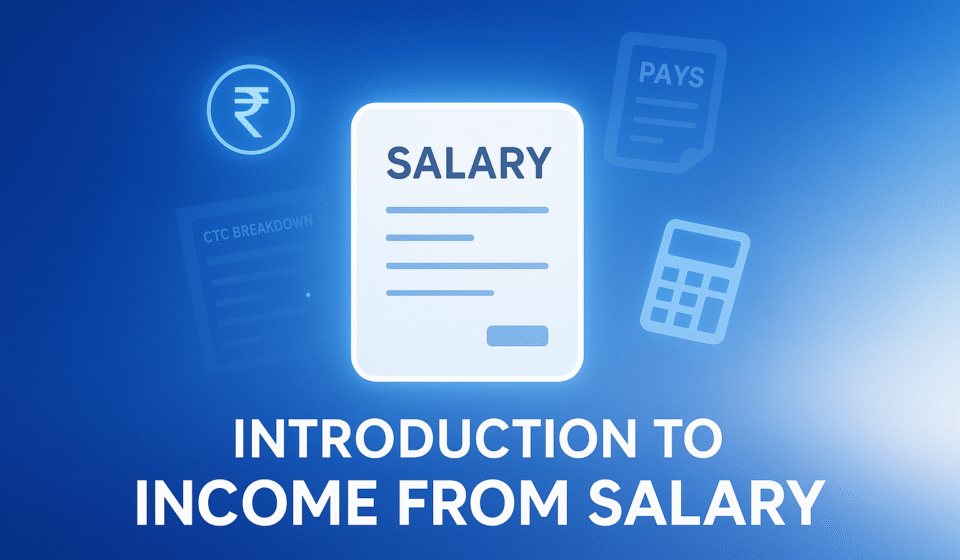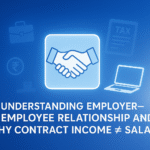
Introduction to Income from Salary – Understand Your Salary Slip & Taxes in Simple Words
Confused why your take-home salary is less than your CTC? Learn in simple language what “Income from Salary” means under the Income Tax Act – allowances, perquisites, deductions, and how your taxable salary is calculated.
Table Of Content
- What “Income from Salary” means
- Why CTC is not the same as take-home salary
- Parts of a salary
- When is salary taxable? (due vs received)
- Quick example: ₹50,000 monthly salary
- Table: CTC vs Gross Salary vs Taxable Salary vs Take-Home (monthly / illustrative)
- Quick checklist for your first salary slip
- what’s next?
- FAQs – Introduction to Income from Salary
- What is meant by “Income from Salary” in the Income Tax Act?
- How is salary income different from business or professional income?
- Why is my take-home salary lower than the CTC shown in my offer letter?
- What are allowances in salary?
- What are perquisites?
- What is “profits in lieu of salary”?
- When is salary considered taxable – on due basis or receipt basis?
- What is the difference between Gross Salary, Taxable Salary, and Take-Home?
- Are retirement benefits like gratuity or pension taxable?
- How can I reduce my taxable salary?
Introduction to Income from Salary
You opens your first salary slip with a smile. The CTC number in his offer letter looked generous; his bank SMS shows a much smaller amount. You surprise at the payslab – basic, HRA, allowances, employer PF, tax deducted – “Why is my take-home so low?” you wonder.
If that sounds familiar, welcome. This article explains Income from Salary simply and step-by-step using the new Income-tax (No.2) Act, 2025 as the legal basis. We’ll keep it practical – no heavy terms – so you can read your slip like a pro.
What “Income from Salary” means
In tax terms, Income from Salary is the money and benefits you receive because of employment. The 2025 Act lists what counts under the salary head: wages, pensions, gratuity, fees or commission, perquisites, profits in lieu of salary, and advances of salary. In short: cash pay plus many employer-provided benefits are treated as salary.
That means even non-cash items – like rent-free accommodation or employer-paid insurance – can affect your tax bill. These are called perquisites in the law.
Why CTC is not the same as take-home salary
CTC (Cost to Company) is a hiring terms: it bundles your gross salary, the employer’s contributions (like employer PF), plus the monetary value of some benefits.
Take-home is what lands in your bank after:
- employee deductions (PF, professional tax),
- TDS (tax deducted at source),
- any other salaries or loan repayments handled through payroll.
Some employer costs in CTC (for example, employer PF contribution, or certain perquisites) are not part of your immediate cash in hand – but can still be taxable. The new Act clarifies which employer contributions are included in salary and which are exempt or partially exempt under the schedules.
Parts of a salary
Here’s what you’ll typically find on a slip:
- Basic pay – the core component, often the base for many calculations.
- Allowances – such as HRA, conveyance, special allowance. Some allowances have special exemptions if conditions are met.
- Perquisites – non-cash benefits (rent-free house, concessional loans, employer-paid premiums, ESOPs). The Act defines and values perquisites.
- Bonuses / Commission – cash rewards; included when paid or due.
- Profits in lieu of salary – compensation on termination, leave encashment or provident fund receipts to the extent they are not the employee’s own contributions.
When is salary taxable? (due vs received)
The Act follows the practical due or received rule for salary: income is chargeable if it is due from the employer in the tax year, or paid/allowed in that tax year – even if not due. In short: tax follows whichever occurs earlier (with anti-double-inclusion safeguards). So if a December salary was due in December but paid in January, it is taxed in the year it was due.
Quick example: ₹50,000 monthly salary
Suppose Your monthly gross components look like this:
- Basic: ₹25,000
- HRA: ₹12,000
- Special allowance: ₹8,000
- Employer PF (CTC part): ₹3,000
- Gross salary (cash): ₹45,000
From this, typical deductions are:
- Employee PF (deducted at source): ₹3,000
- Standard deduction (annual, allowed under the Act; see Schedule/deduction rules) is applied when computing taxable salary.
After PF and TDS, the take-home might be around ₹38,000 – well below the stated CTC which also included employer PF and possible perquisites.
Table: CTC vs Gross Salary vs Taxable Salary vs Take-Home (monthly / illustrative)
| Item | Monthly (₹) |
|---|---|
| CTC (includes employer PF & perqs) | 50,000 |
| Gross salary (cash components) | 45,000 |
| Employee PF (deducted) | −3,000 |
| Taxable salary (approx after standard deduction & exemptions) | 40,000 |
| Take-home (after TDS & deductions) | ~38,000 |
Note: numbers are illustrative. Exact taxable salary depends on exemptions (HRA rules, perquisite valuations) and the Act’s deductions. See sections on perquisites and deductions from salaries in the 2025 Act.
Quick checklist for your first salary slip
- Identify Basic, HRA, Allowances, Employer contributions.
- Check what is listed as a perquisite (any non-cash benefit).
- Note whether any payment is arrears or advance – timing affects tax.
- Keep records of rent receipts (for HRA), loan interest or other proofs needed for exemptions.
what’s next?
This is just the beginning. We’ll decode allowances – HRA, LTA and special allowances – with step-by-step rules from the Income-tax (No.2) Act, 2025.
Sources: Income-tax (No.2) Act, 2025 – Clauses on Salaries, Income from salary, Perquisites, Profits in lieu of salary, and Deductions from salaries. See sections 15–19.
Read More about how to calculate Salary : Tax on Salary
FAQs – Introduction to Income from Salary
What is meant by “Income from Salary” in the Income Tax Act?
Income from Salary refers to all the money and benefits an employee receives from their employer, including basic pay, allowances, perquisites, bonuses, and retirement benefits. It is taxable under the head Salaries in the Income-tax (No.2) Act, 2025.
How is salary income different from business or professional income?
Salary arises only when there is an employer–employee relationship. If you’re self-employed or working on a contract without this relationship, your income is taxed under business/profession, not salary.
Why is my take-home salary lower than the CTC shown in my offer letter?
Because CTC (Cost to Company) includes gross salary + employer’s contributions + some benefits, while take-home is after PF deductions, professional tax, and TDS (income tax deducted at source).
What are allowances in salary?
Allowances are extra payments made by the employer to meet specific expenses – like HRA (House Rent Allowance), LTA (Leave Travel Allowance), or conveyance allowance. Some are partially exempt, some fully taxable.
What are perquisites?
Perquisites are non-cash benefits like rent-free accommodation, concessional loans, free meals, or employer-paid insurance. Under the 2025 Act, these are taxable in the hands of the employee unless specifically exempt.
What is “profits in lieu of salary”?
This means payments received instead of salary like compensation on resignation, retrenchment benefits, or employer contributions from unrecognized funds. These are included in salary income unless exempt under specific provisions.
When is salary considered taxable – on due basis or receipt basis?
Salary is taxed on the earlier of due or receipt basis. For example, if December salary is due in December but paid in January, it is taxed in the year it was due.
What is the difference between Gross Salary, Taxable Salary, and Take-Home?
- Gross Salary = Basic + allowances + bonuses + perquisites.
- Taxable Salary = Gross Salary – deductions allowed under the Act (like standard deduction, HRA exemption).
- Take-Home = Taxable Salary – income tax (TDS) – employee deductions (PF, PT, etc.).
Are retirement benefits like gratuity or pension taxable?
Yes, but partly. Gratuity, leave encashment, commuted pension and similar benefits are taxable, though certain exemptions are available under the Act depending on service period and limits.
How can I reduce my taxable salary?
You can claim:
- Standard deduction (a flat deduction allowed to all salaried employees),
- HRA exemption (if you pay rent),
- Tax-saving investments under Chapter VI-A (like 80C, 80D).
Proper planning can help increase your take-home.



